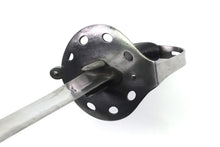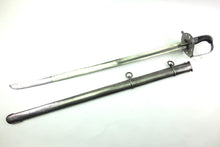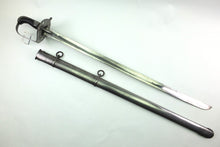
A Very Fine 1796 Heavy Cavalry Troopers Sword.
Missed out on this item? Click to view all current Antique Swords & Edged Weapons Free UK delivery on all items.
40 ½” overall, 35” straight fullered blade, hatchet point. Signed on the back edge ‘Dawes, Birmm.’ With storekeeper’s stamp ‘23RB No.30’and with crowned broad arrow inspectors mark on right hand side. Steel disk hilt with langets, leather covered wooden grip. In its original iron scabbard stamped ‘Osborn & Gunby Birmm’, with two suspension rings one stamped ‘23RB No.30’.
Circa 1807.
In very good condition, blade with nearly all original polish, one of the best 1796 Trooper’s swords we have ever had in stock.
This is an interesting sword as it is a British 1796 but as it has Swedish Regimental marks it is properly a Swedish 1808 Pattern Pallasche, these were issued to two regiments: the Cuirassiers and Carabineers. Britain started send arms to Sweden when they joined the Third Coalition in December 1804.
The War of the Sixth Coalition or German War of Liberation culminated with the great battle of Leipzig – ‘The Battle of the Nations’ - in mid-October 1813. Some 30.000 Swedish made up the Swedish contingent of the Army of the North (totalling some 158.000 including Prussian, Russian and even some very minor elements of British) led by the former French Marshal, now Crown Prince of Sweden, Jean Baptiste Bernadotte. Virtually every Swedish regiment were represented.
Osborn & Gunby in partnership 1807-1820.
Samuel Dawes Birmingham 1774-1835















